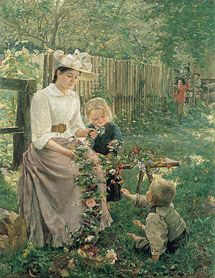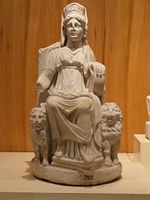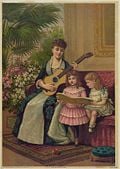Mother's Day
| Mother's Day | |
|---|---|

| |
| Observed by | Many countries |
| Type | Historical |
| Date | Varies regionally |
| Related to | Father's Day |
Mother's Day is a day honoring mothers, celebrated on various days in many places around the world. Officially recognized as a holiday in many countries around the world, Mother's Day celebrates motherhood generally and the positive contributions of mothers to society. It is complemented by Father's Day, a celebration honoring fathers that was established after Mother's Day.
While Christian and pre-Christian societies in Europe commonly celebrated a forerunner of today's holiday, the contemporary Mother's Day in the United States resulted from a campaign for peace and reconciliation after the American Civil War. Julia Ward Howe wrote her Mother's Day Proclamation in 1870, and Anna Marie Jarvis, following the death of her mother on May 9, 1905, devoted her life to establishing Mother's Day as a national, and later an international, holiday.
As the tradition of Mother's Day spread, the emphasis shifted from being a movement for pacifism and reform to an appreciation of mothers in general. Today in the West, particularly the United States, Mother's Day has become a major commercial enterprise, with enormous sums of money spent on flowers, greeting cards, jewelry, pampering gifts such as spa treatments, and dining out. Nevertheless, despite the commercialization and material emphasis, the recognition of mothers on this day does serve to remind all people of the value of motherhood and to appreciate the essential role their mothers played in forming and nurturing them.
Origins
Different countries celebrate Mother's Day on various days of the year because the day has a number of different origins.
There was a custom of mother worship in ancient Greece, which kept a festival to Cybele, the great mother of Greek gods. Cybele was a Phrygian goddess originating in the mythology of ancient Anatolia, whose worship spread to the cities of ancient Greece and the Roman Empire. She represented the Mother Earth and was worshiped as a goddess of fertility, nature, caverns, and mountains, as well as walls and fortresses.
This festival was held around the Vernal Equinox around Asia Minor and eventually in Rome itself from the Ides of March (March 15) to March 18.
The ancient Romans also had another holiday, Matronalia, that was dedicated to Juno, though mothers were usually given gifts on this day.
Spelling
In 1912, Anna Jarvis trademarked the phrases "second Sunday in May" and "Mother's Day," specifying its spelling:
She was specific about the location of the apostrophe; it was to be a singular possessive, for each family to honour their mother, not a plural possessive commemorating all mothers in the world.[1]
This is also the spelling used by U.S. President Woodrow Wilson in the law passed by the U.S. Congress making Mother's Day an official U.S. holiday[2][3] and by other U.S. President in their declarations.[4]
Common usage in English language also dictates that the ostensibly singular possessive "Mother's Day" is the preferred spelling.
The United Kingdom and Ireland
| 2009 | 22 March |
|---|---|
| 2010 | 14 March |
| 2011 | 3 April |
| 2012 | 18 March |
| 2013 | 10 March |
| 2014 | 30 March |
| 2015 | 15 March |
| 2016 | 6 March |
In the United Kingdom and Ireland, Mothering Sunday, also called "Mother's Day," falls on the fourth Sunday of Lent (exactly three weeks before Easter Sunday). Mothering Sunday can fall at the earliest on March 1 (in years when Easter Day falls on March 22) and at the latest on April 4 (when Easter Day falls on April 25.) It is essentially equivalent to Mother's Day, with the latter name being increasingly used, but this is a recent development, and its history is quite different.
Mothering Sunday did not begin as a celebration of motherhood, but a synonym of Laetare Sunday in the Christian liturgical calendar. During the sixteenth century, people returned to their "mother church" for a service to be held on the fourth Sunday of Lent. This was either a large local church, or more often the nearest Cathedral. Anyone who did this was commonly said to have gone "a-mothering."
It was often the only time that whole families could gather together, as they were often prevented from spending time together by conflicting working hours. Young apprentices and young women in servitude were traditionally released by their masters that weekend in order to visit their families.[5] Thus, such gatherings were a time when most mothers would be reunited with their children.
The Epistle for the fourth Sunday in Lent as set out in the Book of Common Prayer gives a special place to the theme of maternal love: Galatians 4:26 states that "Jerusalem which is above is free; which is Mother of us all."
Other names attributed to this festival include Simnel Sunday, Refreshment Sunday, and Rose Sunday. Simnel Sunday is named after the practice of baking Simnel cakes to celebrate the reuniting of families during the austerity of Lent. Because there is traditionally a lightening of Lenten vows on this particular Sunday in celebration of the fellowship of family and church, the lesser-used label of Refreshment Sunday was also used, although rarely today.
Rose Sunday is sometimes used as an alternative title for Mothering Sunday as well, as is witnessed by the purple robes of Lent being replaced in some churches by rose-colored ones. This title refers to the tradition of posies of flowers being collected and distributed at the service originally to all the mothers, but latterly to all women in the congregation. The 1913 Catholic Encyclopedia, however, asserts that "the Golden Rose, sent by the Popes to Catholic sovereigns, used to be blessed at this time, and for this reason the day was sometimes called 'Dominica de Rosa'."[6]
United States
Precedents for the currently observed Mother's Day in the United States include:
- Mothering Sunday
In the UK and Ireland the fourth Sunday of Lent was originally a time when Catholics were supposed to travel to attend Mass in their "Mother Church" (the regional cathedral) rather than in their local parish. By the Reformation, it had changed into an occasion for children to visit parents. An 1854 source mentions a couplet:
On 'Mothering Sunday,' above all other
Every child should dine with its mother.[7]
- Mother's Day Work Clubs
Organized by Anna Jarvis' mother, Ann Maria Reeves Jarvis (1832-1905), to improve sanitation and health in the area, these clubs also assisted both Union and Confederate encampments controlling a typhoid outbreak, and conducted a "Mothers' Friendship Day" to reconcile families divided by the Civil War.
- Julia Ward Howe
Julia Ward Howe instigated "Mother's Day" anti-war observances in 1872:
'Mother's Day,' which was inaugurated in this city on the 2nd of June, 1872, by Mrs. Julia Ward Howe, was celebrated last night at Plimpton Hall by a mother's peace meeting.[8]
Both Jarvis and Howe have been claimed as the "founder of Mother's Day," implying that Julia Ward Howe's June 2nd occasion and Anna Jarvis' second-Sunday-in-May event are one in the same.
Julia Ward Howe's Proclamation
As originally envisioned, Julia Ward Howe's "Mother's Day" was a call for pacifism and disarmament by women. Howe wrote the Mother's Day Proclamation in 1870 as a call for peace and disarmament after the American Civil War:
- Arise, then, women of this day!
- Arise, all women who have hearts,
- Whether our baptism be of water or of tears![9]
However, she failed in her attempt at formal recognition of a Mother's Day for Peace. Although Mother's Day was celebrated in 18 cities in 1873, it did not take root. It continued in Boston for about ten years under Howe's personal financial sponsorship, and then died out.[10]
Early observances
The first known observance of Mother's Day in the U.S. occurred in Albion, Michigan, on May 13, 1877, the second Sunday of the month.[11] According to local legend, Albion pioneer Juliet Calhoun Blakeley stepped up to complete the sermon of the Reverend Myron Daughterty, who was distraught because an anti-temperance group had forced his son and two other temperance advocates to spend the night in a saloon and become publicly drunk. In the pulpit, Blakeley called on other mothers to join her. Blakeley's two sons, both traveling salesmen, were so moved that they vowed to return each year to pay tribute to her and embarked on a campaign to urge their business contacts to do likewise. At their urging, in the early 1880s, the Methodist Episcopal Church in Albion set aside the second Sunday in May to recognize the special contributions of mothers.
On February 4, 1904, South Bend, Indiana resident Frank E. Hering, President of the Fraternal Order of Eagles, made the first known public plea for "a national day to honor our mothers" in 1904.[12]
Anna Jarvis
In 1907, Mother's Day was celebrated by Anna Marie Jarvis in Grafton, West Virginia, to commemorate the anniversary of her mother's death two years earlier on May 9, 1905. Jarvis passed out 500 white carnations at her mother’s church, St. Andrew’s Methodist Episcopal Church in Grafton, West Virginia—one for each mother in the congregation. Jarvis's mother, Anna Maria Reeves Jarvis, had been active in Mother's Day campaigns for peace and worker's safety and health since the end of American Civil War. Jarvis then launched a quest to gain wider recognition of Mother's Day. Grafton is, thus, the place recognized as the birthplace of Mother's Day.
Holiday becomes official
The subsequent campaign to recognize Mother's Day was financed by clothing merchant John Wanamaker. As the custom of Mother's Day spread, the emphasis shifted from the pacifism and reform movements to a general appreciation of mothers. Andrew's Methodist Episcopal Church, the site of the original Mother's Day commemoration where Anna handed out carnations, is now the International Mother's Day Shrine (a National Historic Landmark). From there, the custom caught on—spreading eventually to 46 states.
The holiday was declared officially by some states beginning in 1912, beginning with West Virginia. On May 8, 1914, the U.S. Congress passed a law designating the second Sunday in May as Mother's Day and requesting a proclamation.[13] On May 9, 1914, President Woodrow Wilson made that proclamation, declaring the first national Mother's Day, as a day for American citizens to show the flag in honor of those mothers whose sons had died in war.[14][13]
In 1914 Congress passed a law, which Wilson signed on May 8, 1914, "designating the second Sunday in May as Mother's Day," and authorizing and requesting that Wilson issue a proclamation "calling upon the government officials to display the United States flag on all buildings, and the people of the United States to display the flag at their homes or other suitable places on the second Sunday in May as a public expression of our love and reverence for the mothers of our country."[15]
Carnations have come to represent Mother's Day, since they were delivered at one of its first celebrations by its founder.[14] A colored flower, usually red, indicates the person's mother is living, and a white flower that she is not. The founder, Anna Jarvis, gave a different meaning to the colors. She only delivered a single white carnation to every person, a symbol of the purity of a mother's love.[1][16]
Commercialization
Nine years after the first official Mother's Day, commercialization of the U.S. holiday became so rampant that Anna Jarvis herself became a major opponent of what the holiday had become and spent all her inheritance and the rest of her life fighting what she saw as an abuse of the celebration.[1]
Jarvis criticized the practice of purchasing greeting cards, which she saw as a sign of being too lazy to write a personal letter. She was arrested in 1948 for disturbing the peace while protesting against the commercialization of Mother's Day, and she finally said that she "wished she would have never started the day because it became so out of control."[16]
Mother's Day continues to be one of the most commercially successful U.S. occasions. According to the National Restaurant Association, Mother's Day is now the most popular day of the year to dine out at a restaurant in the United States.[17] Consumers spent an average of $139.14 on Mother's Day gifts in 2007. Items purchased as gifts include jewelry, flowers, candy, housewares and gardening tools, and greeting cards.[18]
International history and traditions
Mother's Day is celebrated on different days in almost every month throughout the world. For example, Greece celebrates a Mother's Day on February 2, Afghanistan on March 8, Armenia on April 7, Spain on the first Sunday of May, Mongolia (Mother's and Children's Day) on June 1, Costa Rica on August 15 (Assumption Day), Malawai on the second Monday of October, Russia on the last Sunday of November, and Panama on December 8.
The extent of the celebrations varies greatly. In some countries, it is potentially offensive to one's mother not to mark Mother's Day. In others, it is a little-known festival celebrated mainly by immigrants, or covered by the media as a taste of foreign culture.
In most countries, Mother's Day is a recent observance derived from the holiday as it evolved in North America and Europe. Many African countries adopted the idea of one Mother's Day from the British tradition, although there are many festivals and events celebrating mothers within the many diverse cultures on the African continent that long pre-date colonization. Other countries have also established a Mother's Day tradition along the lines of their own cultures.
Japan
Mother's Day in Japan was initially commemorated during the Shōwa period (1926–1989) as the birthday of Empress Kōjun (mother of Emperor Akihito). Nowadays—as in the United States—the holiday is a heavily marketed concept, and people typically give flowers such as carnations and roses as gifts.
China
In China, in recent years some people began to advocate for the official adoption of Mother's Day in memory of Meng Mu, the mother of Mèng Zǐ (371 – 289 B.C.E.) It remains an unofficial festival except in a small number of cities.
Greece
Mother's Day in Greece corresponds to the Eastern Orthodox feast day of the Presentation of Jesus at the Temple. Since the Theotokos (Mother of God) appears prominently in this feast as the one who brought Christ to the Temple at Jerusalem, this feast is associated with mothers.
Notes
- ↑ 1.0 1.1 1.2 Louisa Taylor, Mother's Day creator likely 'spinning in her grave', The Vancouver Sun, May 11, 2008. Retrieved January 19, 2009.
- ↑ House Vote #274 (May 7, 2008), H. Res. 1113: Celebrating the role of mothers in the United States and supporting the goals and ideals of Mother's Day (Vote On Passage). Retrieved January 19, 2009.
- ↑ House Vote #275 (May 7, 2008), Table Motion to Reconsider: H RES 1113 Celebrating the role of mothers in the United States and supporting the goals and ideals of Mother’s Day. Retrieved January 19, 2009.
- ↑ Presidential proclamations from The American Presidency Project:
- 71 - Mother's Day Proclamation, Franklin D. Roosevelt, May 3, 1934. Retrieved January 19, 2009.
- Proclamation 3535 Mother's Day, 1963, John F. Kennedy, April 26, 1963. Retrieved January 19, 2009.
- Proclamation 3583 - Mother's Day, 1964, Lyndon B. Johnson, April 23, 1964. Retrieved January 19, 2009.
- Proclamation 4437 - Mother's Day, 1976, Gerald Ford, May 5, 1976. Retrieved January 19, 2009.
- Proclamation 6133 - Mother's Day, 1990, George Bush, May 10, 1990. Retrieved January 19, 2009.
- Proclamation 6559 - Mother's Day, 1993, Bill J. Clinton, May 7, 1993. Retrieved January 19, 2009.
- Proclamation 8253 - Mother's Day, 2008, George W. Bush, May 8, 2008. Retrieved January 19, 2009.
- ↑ Religion & Ethics, Mothering Sunday, bbc.co.uk, 2006-02-27. Retrieved January 19, 2009.
- ↑ P. M. J. Rock, Golden Rose, The Catholic Encyclopedia Vol. 6, (New York, NY: Robert Appleton Company, 1909). Retrieved January 19, 2009.
- ↑ Anne Elizabeth Baker, Glossary of Northamptonshire Words and Phrases, (Northampton: Abel & Sons, and Mark Dorman, 1854), 33. Digitized Feb 23, 2006. Retrieved January 19, 2009.
- ↑ "The First Anniversary of 'Mother's Day'", The New York Times, June 3, 1874, p. 8:. Retrieved January 19, 2009.
- ↑ Susan Tracy Rice, Mother's Day: It's History, Origin, Celebration, Spirit, and Significances Related in Prose and Verse (Whitefish, MT: Kessinger Publishing, 2007, ISBN 978-0548064146
- ↑ Jone Johnson Lewis, Julia Ward Howe's Mother's Day for Peace, About.com: Women's History, 2007. Retrieved January 19, 2009.
- ↑ Albion's Historical Markers, Mother's Day, Albion Michigan Homepage, 2001. Retrieved January 19, 2009.
- ↑ The History of Mother's Day, Fraternal Order of Eagles, 2008. Retrieved January 19, 2009.
- ↑ 13.0 13.1 Susan Tracey Rice and Robert Haven Schauffler, Mother's Day: Its History, Origin, Celebration, Spirit, and Significance as Related in Prose and Verse. (New York, NY: Moffat, Yard and Company, 1915), 6. Retrieved January 19, 2009.
- ↑ 14.0 14.1 Today in History: May 9, Library of Congress. Retrieved January 19, 2009.
- ↑ Rice and Schauffler, 1915, 4-5. Retrieved January 19, 2009.
- ↑ 16.0 16.1 Associated Press, Mother's Day reaches 100th anniversary, The woman who lobbied for this day would berate you for buying a card, MSNBC, May. 11, 2008. Retrieved January 19, 2009.
- ↑ National Restaurant Association, Mother's Day Dining Fact Sheet, April 30, 2009. Retrieved April 12, 2010.
- ↑ Supermarket industry news, Consumers Will Still Spend for Mother's Day, Just Not as Much: Survey, Progressive Grocer, April 23, 2008. Retrieved January 19, 2009.
ReferencesISBN links support NWE through referral fees
- Graham, Ruth Bell. Blessings for a Mother's Day. Nashville, TN: Thomas Nelson Publishing, 2002. ISBN 978-0849990502
- Rathjen, Lelinda. Ideals Mother's Day. Nashville, TN: Ideals Publications, 2008. ISBN 978-0824913182
- Rice, Susan Tracy. Mother's Day: Its History, Origin, Celebration, Spirit, and Significances Related in Prose and Verse. (1915) reprint ed. Whitefish, MT: Kessinger Publishing, 2007. ISBN 978-0548064146
- Rice, Susan Tracy, and Robert Haven Schauffler. Mother's Day: Its History, Origin, Celebration, Spirit, and Significance as Related in Prose and Verse. Moffart, Yard & Company, 1915. reprint ed. Whitefish, MT: Kessinger Pub., 2005. ISBN 9781417995769.
- Schmidt, Leigh Eric. Consumer Rites: The Buying & Selling of American Holidays. Princeton, NJ: Princeton University Press, 1995. ISBN 978-0691029801
External links
All links retrieved November 10, 2022.
| |||||||
Credits
New World Encyclopedia writers and editors rewrote and completed the Wikipedia article in accordance with New World Encyclopedia standards. This article abides by terms of the Creative Commons CC-by-sa 3.0 License (CC-by-sa), which may be used and disseminated with proper attribution. Credit is due under the terms of this license that can reference both the New World Encyclopedia contributors and the selfless volunteer contributors of the Wikimedia Foundation. To cite this article click here for a list of acceptable citing formats.The history of earlier contributions by wikipedians is accessible to researchers here:
The history of this article since it was imported to New World Encyclopedia:
Note: Some restrictions may apply to use of individual images which are separately licensed.





